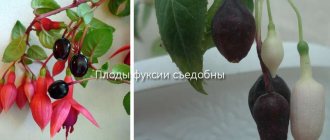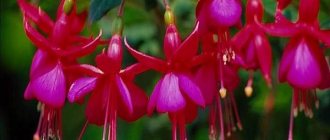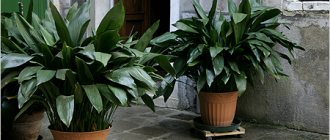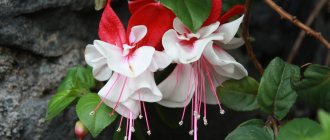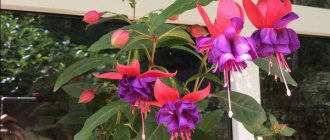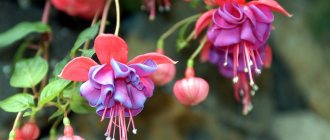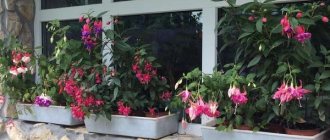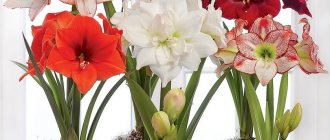Author: Elena N. https://floristics.info/ru/index.php?option=com_contact&view=contact&id=19 Category: Houseplants Published: June 11, 2012Republished: February 10, 2019Last edits: March 16, 2021
- Fuchsia fulgens
Botanical description
Fuchsia (lat. Fuchsia) is a plant belonging to the fireweed family and numbering up to 100 species. The plant was named after the German botanist Fuchs. Under natural conditions, it is widespread in South and Central America. Fuchsia, depending on the variety, is trees or small shrubs. In some species the leaves grow oppositely, in others - in whorls; Some types of fuchsia shed their leaves after the end of the growing season. The leaves are lanceolate, elongated oval or ovoid; The edges of the leaves can be either whole or with small serrations. Flower calyxes are tubular and elongated, most often white or red with long stamens. Even an amateur gardener can grow fuchsia - the plant is quite easy to care for. They are grown both as hanging plants and standard trees. One of the important conditions for caring for fuchsia is that the plant should overwinter in cool conditions. Another difficulty is that the plant sheds its leaves after flowering.
Description of the plant and features of fuchsia
The first mention of fuchsias was recorded about 300 years ago, and since then, breeders have developed more than a thousand varieties of these beauties. There are ampelous and bush varieties of fuchsias.
Spectacular, graceful, fuchsia has become famous for its unique flowers, which cannot be confused with any other plant. Flowers are double, semi-double and simple. The group for home floriculture is varied in shades. There are white, lilac, pink, beige, violet. You can often observe combinations of 2-3 shades in the structure of one bud.
The fuchsia plant (Fuchsia) is a member of the fireweed family.
Fuchsia, a well-known houseplant, has acquired a “second wind” with the production of hybrids capable, firstly, of propagation by seeds, and, secondly, of blooming relatively soon, 4-5 months after sowing. Since several species are mixed in the “blood” of this hybrid, it is often called hybrid fuchsia (F. x hybrida). But it is not only the ability to bloom in the year of sowing that allows fuchsia to be classified as an annual plant. More importantly, it blooms all summer in open ground. At the same time, fuchsia remains a perennial; in winter it can be kept in a cool, bright room and cut out in the spring. Fuchsias bloom from July until the first frost.
Indoor fuchsias (Fuchsia hybrids, Fuchsia x hybrida) are much more elegant than those that grow in natural conditions. In nature, they resemble small spreading trees or lush shrubs, strewn with clusters of fragrant flowers. Fuchsia appeared in Europe in the 17th century thanks to the explorer and botanist Leonard Fuchs. At first it was considered a great curiosity and was grown in the winter gardens of nobles.
Gradually, hybrid varieties were developed that were more adapted to northern latitudes. This is how bush, ampel and semi-ampel forms of fuchsias appeared. Today, it is very rare to find species of fuchsias in indoor culture; in the vast majority of indoor fuchsias, they are hybrids.
Fuchsia has enormous potential and many advantages.
Fuchsias provide a considerable choice of possibilities for changing the form of cultivation. They are good both as hanging crops or graceful vines with shoots hanging down, and as graceful bushes, and as plants formed on a figured support. They can even be driven out in standard form, forming trees of amazing beauty.
Today, fuchsias are represented by spreading, ampelous and upright growing varieties with a height of 30 to 70 cm, with flowing, straight or creeping, partially woody shoots, up to 70 cm long. The shape of a fuchsia bush can be easily controlled by pinching. The leaves are large to medium-sized, ovate-lanceolate or oval with pointed tips and pronounced veins, most often with a serrated edge.
The most attractive thing about fuchsias is their flowers. They are considered exemplary graceful not only because they droop down and elegantly hang on their stalks. The flowers of this plant have been compared to dancers and their spectacular skirts. Some have completely different associations - with elegant lanterns. And the structure of the flower really has a lot in common with the outfits of ballerinas. In fuchsias, the flower consists of a calyx and a corolla. The elegant calyx resembles a simple flower with petal-shaped sepals, on which lies a bell-shaped corolla.
Ordinary fuchsia is far from being as simple as it might seem: it has enormous potential and many advantages.
Small classic varieties with 4-5 corolla petals compete today with varieties with giant double flowers, the corolla of which offers you to admire the most bizarre curvatures and shapes. Narrow and long, short and wide, large, small, twisted, with ruffles - fuchsia corolla petals can be anything you want. But it’s also worth taking a closer look at the calyxes: in some fuchsias the sepals are straight and lanceolate, in others they are ovate and drooping down, in others they are raised up. And the stamens, which are always longer than the corolla, only emphasize the gracefulness of the plant.
The fuchsia color palette today can surprise even artists. The calyx and corolla almost always differ in color. A light cup and a dark corolla, or vice versa, contrasting tones or similar shades, completely different in color saturation, are mixed in limitless variations, and sometimes we are not even talking about two-color combinations: transitions, play, variegated spots significantly expand the idea of the palette. Fuchsia colors include white, cream, light green, blue, lilac, violet, red and pink.
Briefly about cultivation
- Flowering: from spring to late autumn.
- Lighting: bright diffused light.
- Temperature: during the growing season – 18-24 ºC, in winter – 5-10 ºC.
- Watering: from March to September - immediately after the top layer of soil has dried, and from the end of November - only occasionally, not allowing the earthen ball to dry out completely.
- Air humidity: from May to August, spraying with warm water is needed early in the morning and in the evening, and in the fall - once every 2-3 days. In winter, spraying is stopped.
- Feeding: from April to September - every two weeks with complex mineral fertilizer for flowering plants.
- Dormant period: from late October to late January.
- Trimming: at the beginning of the active. Shoots of ampelous fuchsia varieties are not pruned.
- Transplantation: annually in early March, after pruning.
- Substrate: 3 parts leaf soil, 2 parts peat and 1 part sand.
- Reproduction: seeds and cuttings.
- Pests: whiteflies and spider mites.
- Diseases: spotting, rot, loss of decorativeness due to violation of maintenance conditions or improper care.
Read more about growing fuchsia below.
Table: conditions of detention depending on the season
| Season | Lighting | Optimal temperature conditions | Humidity | Accommodation |
| Spring, summer and autumn | The plant is a light-loving plant, but it must be protected from exposure to direct sunlight. | It is desirable that the temperature be within +18…22°C | The optimal humidity level is 50%. It is recommended to place wide containers of water near the flower or place the pot with the plant on a tray with wet pebbles. On hot days, the pet should be additionally sprayed with settled water in the mornings and evenings. | It is recommended to place the pot on an east or west windowsill. In summer it is better to take it out onto the balcony |
| Winter | It is advisable to provide fuchsia with 12-hour additional lighting using a fluorescent lamp | The room temperature should not rise above +18 °C | Spraying is not required in winter. Humidity should be maintained at the same level | It is advisable to move the pot to the basement. If the plant is left on the window sill in the room for the winter, then it needs to be moved away from heating appliances. |
Caring for fuchsia at home
Lighting
The optimal location of the fuchsia plant is considered to be windows on the eastern and western windows, since the plant needs a lot of bright, but diffused light. Can tolerate direct sunlight in the morning and evening. If fuchsia is placed on a south-facing window at home, then the plant must be covered with a translucent cloth or paper to avoid burns. On the north side, lack of lighting can lead to stretching of the plant and poor flowering (or lack thereof). When indoor fuchsia blooms, it should not be rearranged or rotated, as this may cause the plant to shed its buds and leaves. Fuchsia can be taken outside in the summer, but this must be done gradually, accustoming it to new conditions.
Temperature
Air temperature during the growing season can range from 18 to 24 °C. Fuchsia should overwinter in a cool place (5 to 10 °C above zero) with good lighting. At higher temperatures, fuchsia sheds its leaves and the shoots elongate. The plant needs an influx of fresh air, but it must be ventilated carefully, since drafts can destroy the plant. In summer, the plant can be placed on the balcony, providing suitable conditions - absence of precipitation, draft and direct sunlight.
Watering fuchsia
Water homemade fuchsia with soft, settled water at room temperature. From March to September, water immediately after the top layer of soil has dried, since at this time the substrate should be constantly slightly moist. From October, the frequency of watering is reduced, and by the end of November it almost stops (this will contribute to more abundant flowering next year). When keeping fuchsia in winter at temperatures up to 10 °C, it is watered very rarely, and when wintering above 10 °C - a little more often.
- How I filled Yucca... and not only
Spraying
Spray the fuchsia flower with soft water - you need to let the water sit for 24 hours before spraying. From May to August, spray twice a day - before 9 am and after 6 pm. In autumn, spray once every two to three days. There is no need to spray the plant in winter.
Top dressing
From April to September, the fuchsia plant is fed every 2-3 weeks with complex mineral fertilizers for indoor plants. In winter, the plant does not need feeding.
Bloom
Compliance with all the conditions for keeping fuchsia indoors will give it the opportunity to bloom from May to November, and even produce berry-like juicy fruits. Withered flowers must be removed - this helps the plant form young buds. Moving fuchsia to the balcony in July and pruning it three times over the summer will promote long-term flowering - right up to December.
Trimming
Overwintering fuchsia at room temperature causes the stems to stretch and the leaves to fall off. Since flowers are formed mainly on young shoots, in order to promote their development, old bare shoots need to be pruned (they can be used for propagation by cuttings). Throughout the growing season, indoor fuchsia flowers are cut and pinched. Pinch out young shoots after three pairs of leaves have formed.
To form a tree, one vertically growing shoot is attached to a vertical support and all side shoots are pruned until the trunk reaches the desired height. After this, the top is cut off and 3-5 side shoots are allowed to develop, which will form the crown of the tree. In three years, a beautiful lush crown will form.
Fuchsia transplant
Indoor fuchsia is transplanted annually in early March. Before transplanting, cut off old shoots by at least a third and slightly shorten the roots. In ampelous species, the shoots are not shortened, since the plant loses its decorative effect. Replant fuchsia in slightly acidic soil consisting of deciduous soil, peat and sand (3: 2: 1). Another substrate option is 3 parts of clay-turf soil, 2 parts of greenhouse soil and 1 part. sand (and some peat chips). Drainage is poured into the bottom of the pot to one-fifth of its height. After transplantation, the plant is generously sprayed and watered, and placed in a place with bright, diffused light. In mid-summer, home fuchsia can be replanted in fresh soil.
- How to water flowers (part 1)
Growing from seeds
To obtain fuchsia seeds, you need to artificially pollinate. By pollinating different types of fuchsias with different shapes and shades of flowers, you can get a new hybrid.
Propagation by cuttings
When propagating by cuttings, cuttings 5-7 cm in length are needed. To root, fuchsia cuttings are placed in water or one end is buried in sand. The cuttings will take root within 3-4 weeks. The cuttings are planted in 9-centimeter individual pots in a substrate of equal parts of humus, leaf and turf soil, and sand. To grow lush bushes, cuttings need to be planted several in one pot. Young domestic fuchsias should bloom in the same year. Species that grow slowly are best propagated by cuttings in late summer.
Varieties with photos and names for growing in pots (ampeloid)
Pots are the most convenient container for growing ampel plant varieties at home, for example, on a balcony. Hanging pots allow the plant stems to curl beautifully, decorating a balcony or wall. Unlike climbing forms of plants, ampelous varieties do not wrap around a support, but hang from the pots. They can only be grown in hanging boxes and flowerpots - they will not look good in ordinary pots.
In addition to hanging ones, there are also other varieties - tree-like, shrubby, upright.
Their cultivation requires completely different conditions. Advice! However, fuchsia is considered one of the most unpretentious plants, convenient for inexperienced gardeners, as well as for very busy ones.
Listed below are some varieties of ampelous fuchsia.
Golden Marinka
This plant is distinguished by beautiful red flowers of an elongated shape, with a white core inside. The leaves are quite light, golden-green.
Golden marinka is distinguished by lush flowering and even more abundant branching. For successful care, it is necessary to pinch off excess stems so that the fuchsia greens are not too thick to the detriment of flowering.
Icicle
This fuchsia differs from other varieties in its delicate white color. Unlike other fuchsias, which are colored in shades of red and even give their name to one of the flowers, Icicle has large white buds.
This is a very unusual ampelous form, but as unpretentious as other fuchsias. There may be a pinkish tint to the outer petals (flower skirt).
First love
The romantic name of this variety emphasizes the tenderness and beauty of its flowers. Color – purple, from delicate to rich, a reddish tint is possible, some petals may be white. The intensity of color depends on several factors - the abundance of flowering, the lifespan of a particular plant, lighting, and soil characteristics.
Diseases and pests
Fuchsia is sick. Fuchsias do not tolerate stagnant air well - during the growing season the room must be regularly ventilated or the fuchsia must be placed on the balcony.
Fuchsia fades quickly. Fuchsia can bloom for a short period with abundant watering and keeping in warm conditions in winter; in case of insufficient lighting in spring and summer; with insufficient watering and fertilizing in summer.
Fuchsia leaves are falling off. If fuchsia sheds its leaves in winter, the plant can be removed from bright light, and the emerging buds must be pinched.
Fuchsia is shedding its leaves. Leaves may fall off if humidity is too low, watering is poor, and temperatures are too high.
Fuchsia buds fall off when there is insufficient light and too warm air, as well as when watering is irregular.
- How to properly care for cyclamen
Spots on fuchsia leaves. The plant may develop spotting if the plant is watered too often in winter.
Fuchsia has dropped its buds. During flowering or the appearance of buds, the plant cannot be moved - it may drop the buds. The same consequences will occur if fuchsia is placed in a draft.
Fuchsia pests. Most often, fuchsias are bothered by whiteflies and spider mites.
Propagation of fuchsia by cuttings
For cuttings, you should take young fuchsia cuttings. Slightly woody fuchsia cuttings will also produce roots, but the process may take a little longer. The length of the fuchsia cuttings may depend on the variety, since there are vigorous and very compact varieties of fuchsias. On average, the length of a fuchsia cutting can be 10-20 cm. Before placing the fuchsia cutting in a container of water, it is necessary to remove all lower leaves that may come into contact with water. Touching water, fuchsia leaves can begin to rot, the infection spreads quickly and fuchsia cuttings can rot before they have time to take root.
Propagation by cuttings is best done at the same time as pruning.
You can also cut the remaining leaves by half if they are too large, since excessive evaporation of moisture through large leaves can weaken the fuchsia cutting, which does not yet have its own roots. If, nevertheless, the leaves of the fuchsia cuttings have lost their turgor, place the glass with the cuttings in a greenhouse or simply cover with a transparent bag. Regular filtered water will do. It makes no sense to use special hormones for rooting fuchsia, since fuchsia cuttings readily and quickly produce roots.
It happens that already on the fourth day after cutting the fuchsia cuttings, the first roots appear. On average, the process of root formation in fuchsia takes 10-14 days. There is no need to wait for the fuchsia cuttings to grow long roots. You can plant fuchsia in the substrate as soon as several young roots appear on the cuttings.
You can propagate fuchsias by cuttings at any time of the year, but it is best in the spring, when all living things begin to grow. Since fuchsia loves cool weather, in summer, due to high air temperatures, fuchsia propagation is difficult - cuttings often rot before they have time to take root. The problem of fuchsia propagation in summer can be solved if the cuttings are kept in a room with air conditioning. Also, you may encounter problems with fuchsia propagation in the fall. The fact is that fuchsia has a dormant period, which lasts from mid-October to the end of January. During this period, all vital processes in fuchsia slow down.
To collect seeds from indoor fuchsia, its flowers will require artificial pollination.
The second method of propagating fuchsia is by cuttings. Freshly cut fuchsia cuttings are immediately planted in a substrate (this can be a peat tablet, vermiculite, perlite, sphagnum). The disadvantage of this method is that fuchsia cuttings planted without roots must be placed in a greenhouse, since the fuchsia leaves will certainly lose turgor. But fuchsias very quickly get used to the greenhouse, that is, to high air humidity. When the time comes, the rooted cuttings should be removed from the greenhouse, and they will have to be adapted to normal air humidity for some time. Unadapted fuchsia cuttings may lose some turgor during a sudden climate change.
Kinds
Fuchsia fulgens
Found naturally in the Mexican mountains. These are one to two meter evergreen shrubs with bare branched shoots. The leaves are large, elongated egg-shaped or heart-shaped; they reach 20 cm in length and 12 cm in width, not pubescent, serrated along the edge. Reddish flowers grow in pendulous racemes at the top of the shoots; the corolla tube tapers towards the base and reaches a length of up to 10 cm; petals are up to 10 cm long. The fruit is an edible berry. The flowering period is all summer.
Bolivian Fuchsia / Fuchsia boliviana
It lives in the mountainous regions of Argentina, Ecuador and Bolivia. Evergreen shrubs growing in height up to a little over 1 m. The leaves are pointed at the apex, ovoid or elliptical in shape with small jagged edges, reach 15 cm in length and 6 cm in width. It blooms in early to mid-spring with dark red 1-cm flowers collected in apical racemes.
Fuchsia Magellanica / Fuchsia magellanica
Also known as Fuchsia discolor or Fuchsia conica. Shrubs growing in height from 2 to 5 m. The shoots are slightly pubescent, purple in color. The leaves grow either in whorls of 3 or alternately, reach a length of up to 5 cm, are ovate-lanceolate, serrated at the edges, covered with purple veins. The flowers are axillary and grow either singly or in groups of 4. The corolla tube is reddish, and the petals are bluish-purple. The flowering period is from late spring to late summer.
Fuchsia corymbiflora
It lives on mountain slopes in Ecuador and Peru. Shrubs with straight stems grow up to 5 m in height. Leaves are up to 17 cm long and up to 7 cm wide, oval in shape, slightly pubescent, smooth edge, red central vein. The calyx tube is red, the petals are purple. Flowering period is July-August.
Propagation of fuchsia by seeds
This difficult, but undoubtedly the most interesting method of propagating fuchsia makes sense only for breeding purposes.
The flower of the fuchsia mother plant must be protected from possible self-pollination. It is also important to exclude the possibility of pollination of the fuchsia flower by insects. Therefore, the anthers of a freshly blossomed, or better yet, flower that has not yet blossomed, are carefully and carefully removed. Pollen from the parent fuchsia plant is applied to the stigma of the pistil. Next, you should isolate the flower by putting an insulating bag on it - this will prevent accidental pollination by insects. An insulating bag can be made from available materials - paper, fabric, secured around the flower with threads.
To propagate by seeds, they are placed in soil made of sand and vermiculite.
The fuchsia fruit takes several weeks to ripen.
The fuchsia fruit is carefully cut and the seeds are removed. Now they need to be dried. In a day or two, the seeds will dry and they can be sown. Fuchsia seeds are sown on top of a slightly moistened substrate, without being embedded in the soil. The bowls with seeds must be placed in a greenhouse, in a well-lit place at room temperature. Fuchsia seedlings will appear in about two weeks. After a month and a half or two, the seedlings dive, planting them at a greater distance from each other. After another two months, the seedlings can be planted in separate cups.
Before young fuchsia plants are removed from the greenhouses, they must be gradually accustomed to normal air humidity. Unadapted fuchsia seedlings can suffer greatly and even die if adaptation is neglected.
Transfer
Fuchsia (photos of flowers with proper planting and care are simply stunning) is a fast-growing plant. Therefore, frequent transplants are simply necessary. For each subsequent procedure, take a pot that is three to four centimeters larger than the previous one. It is better to replant in the spring so that the flowers have time to get stronger and adapt to the new soil before the onset of winter.
It is best to use ceramic containers for growing fuchsia. They do not heat up so much, so they will provide the most comfortable conditions for the plant in the summer heat and protect it from overheating. There must be a drainage at least two centimeters thick at the bottom. When replanting, be sure to completely change the soil. The best substrate for this is one intended for growing indoor flowers, which can be purchased at any specialized store. You can also make it yourself if you mix leaf and turf soil, peat, humus and coarse sand in equal proportions.
After completing the procedure, the fuchsia shoots are cut to one third of the total length, watered and placed on a shelf under artificial lighting. They begin to feed no earlier than thirty days after transplantation. The first flowering usually occurs in the third month. If you do everything correctly, it will be lush and plentiful.
Content Features
The indoor fuchsia flower is very unpretentious, so even beginners do not have any special problems with it. All care consists of creating a suitable microclimate for it, as well as providing timely watering and fertilizing. If you follow some recommendations, the plant will bloom long and profusely and delight you with its incredibly beautiful flowers. All the nuances will be discussed in more detail below.
Popular questions and answers
We talked about growing fuchsia and the problems that arise with a candidate of agricultural sciences. Sciences Irina Titova.
How to choose fuchsia?
Fuchsias are grown in bush, ampelous and standard forms. Almost any variety can be grown in all three varieties, and bush fuchsia can also be made into an ampel or standard form and vice versa. So the main thing for a florist is the beauty of the flowers, and this is a matter of taste.
What kind of pot is needed for fuchsia?
For fuchsias, choose light-colored pots and flowerpots, or cover them from the sun. Ceramic products are preferred. It is useful to cover the soil surface with light wood chips, small pebbles, and marble chips to protect the roots from overheating.
Why do fuchsia leaves fall off?
The most likely reason for fuchsia leaves to fall is warm, dry air. Spray the plants with a spray bottle every 2 days or more often. If possible, expose them to the open air.
Why do fuchsia leaves dry out?
This happens when there is a lack of moisture and, conversely, when the soil is waterlogged in the cold and dark season. If spots appear on the leaves, fungal diseases are likely developing. The lower leaves often dry out and fall off due to insufficient watering or poor lighting.
Why do fuchsia buds fall off?
Most likely this is the result of a violation of the watering regime - too much or too little water. Other possible reasons are very high or, conversely, low air temperature and lack of light. Sometimes the buds fall off if the plant is moved to a new place or turned in relation to the light source.
Why does fuchsia wither?
This can happen if the plant is kept in a warm room in winter, as well as if there is a lack of water and nutrients, or if there is not enough light during the period of active growth. Another reason is overheating of the earthen coma.
Why doesn't fuchsia bloom?
Mature fuchsia does not bloom under unfavorable conditions. Analyze how your fuchsia lives. Surely establish the reason, take action, and the fuchsia will bloom.
Sources
- Fuchsia // The Plant List https://www.theplantlist.org/1.1/browse/A/Onagraceae/Fuchsia/
- Farm laborer E.R. Fuchsia // M.: Kladez-Buks, 2006
- Bartlett G. Fuchsias // The Crowwood Press Ltd, 2007
- Bartlett G. Fuchsias Step by Step to Growing Success // The Crowwood Press Ltd, 1996
- Shvelidze S. Fuchsia. At the peak of fashion // M.: Fiton+, 2006
- Nicholas J. Fuchsias // Aquamarine, 2008
- Markina T. Fuchsia. Maintenance, breeding, care // M.: InterService, Presscom, 2004
- Dubrovskaya S. Fuchsia: development and care // M.: Ripol Classic, 2006
- State catalog of pesticides and agrochemicals approved for use on the territory of the Russian Federation as of July 6, 2022 // Ministry of Agriculture of the Russian Federation https://mcx.gov.ru/ministry/departments/departament-rastenievodstva-mekhanizatsii-khimizatsii- i-zashchity-rasteniy/industry-information/info-gosudarstvennaya-usluga-po-gosudarstvennoy-registratsii-pestitsidov-i-agrokhimikatov/
